BSc (Hons) Business Management: Types of Companies Report, BMP3002
VerifiedAdded on 2022/12/26
|10
|2564
|65
Report
AI Summary
This report provides a comprehensive analysis of different types of companies, ranging from micro to large businesses, including their characteristics and operational structures. It delves into sole trader businesses, partnerships, limited liability companies, public limited liability businesses, and cooperatives. The report further explores the impact of organizational structures, such as functional and divisional structures, on business productivity. Additionally, it applies a PESTLE analysis to Morrisons, examining how political, economic, social, technological, legal, and environmental factors affect the company's performance. The report concludes with a synthesis of these elements, offering a holistic view of the business landscape and external influences.
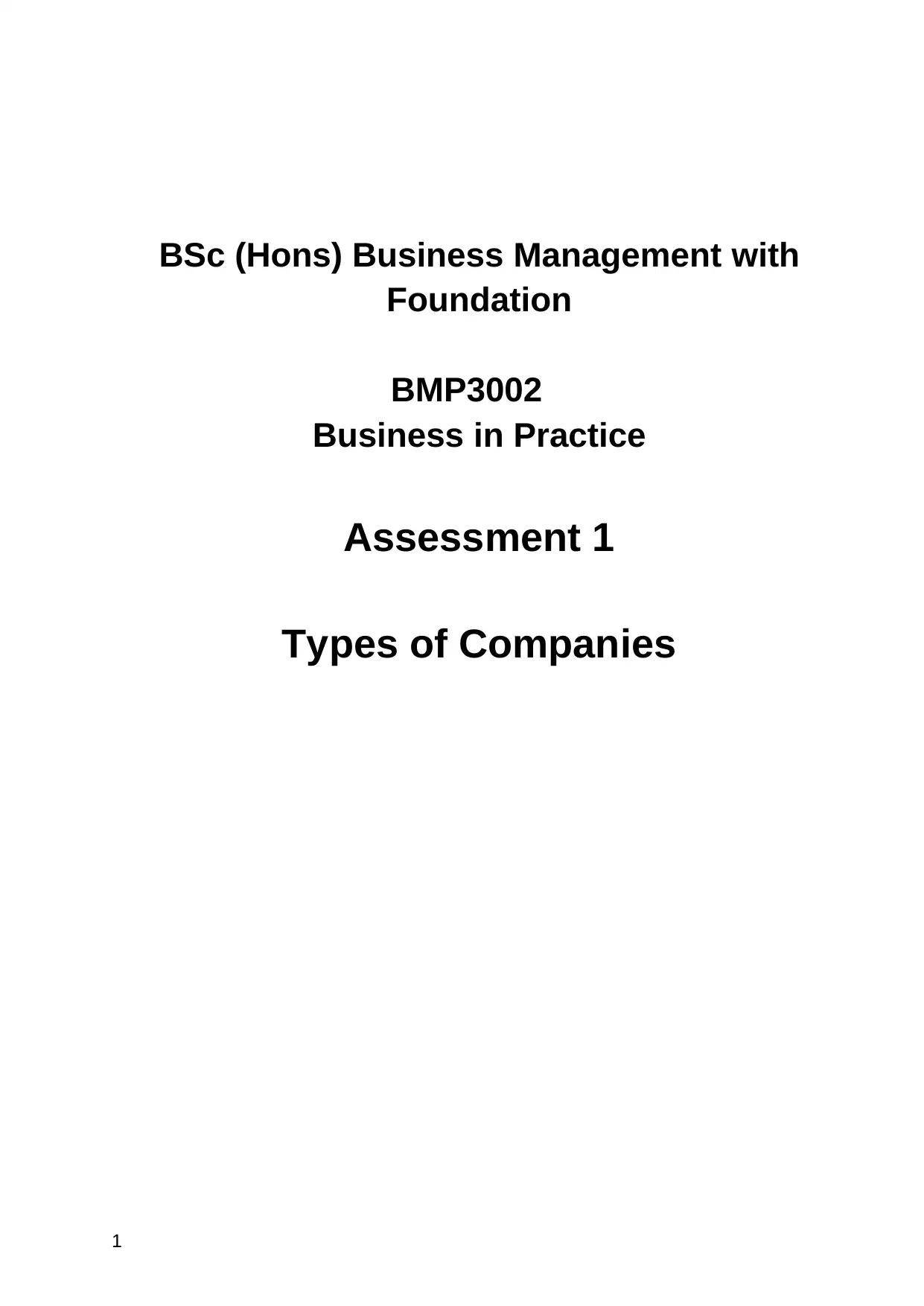
BSc (Hons) Business Management with
Foundation
BMP3002
Business in Practice
Assessment 1
Types of Companies
1
Foundation
BMP3002
Business in Practice
Assessment 1
Types of Companies
1
Paraphrase This Document
Need a fresh take? Get an instant paraphrase of this document with our AI Paraphraser
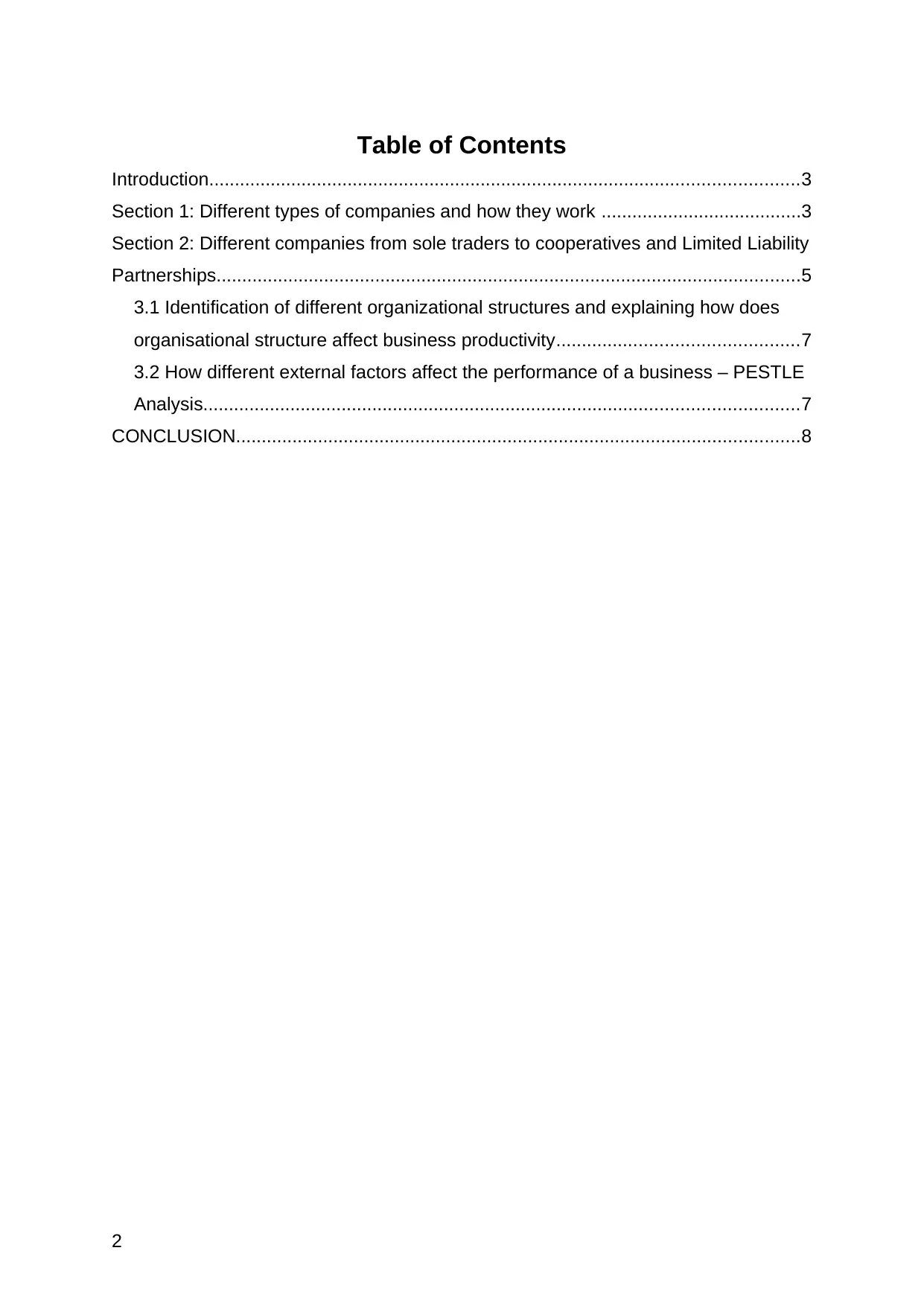
Table of Contents
Introduction...................................................................................................................3
Section 1: Different types of companies and how they work .......................................3
Section 2: Different companies from sole traders to cooperatives and Limited Liability
Partnerships..................................................................................................................5
3.1 Identification of different organizational structures and explaining how does
organisational structure affect business productivity...............................................7
3.2 How different external factors affect the performance of a business – PESTLE
Analysis....................................................................................................................7
CONCLUSION..............................................................................................................8
2
Introduction...................................................................................................................3
Section 1: Different types of companies and how they work .......................................3
Section 2: Different companies from sole traders to cooperatives and Limited Liability
Partnerships..................................................................................................................5
3.1 Identification of different organizational structures and explaining how does
organisational structure affect business productivity...............................................7
3.2 How different external factors affect the performance of a business – PESTLE
Analysis....................................................................................................................7
CONCLUSION..............................................................................................................8
2
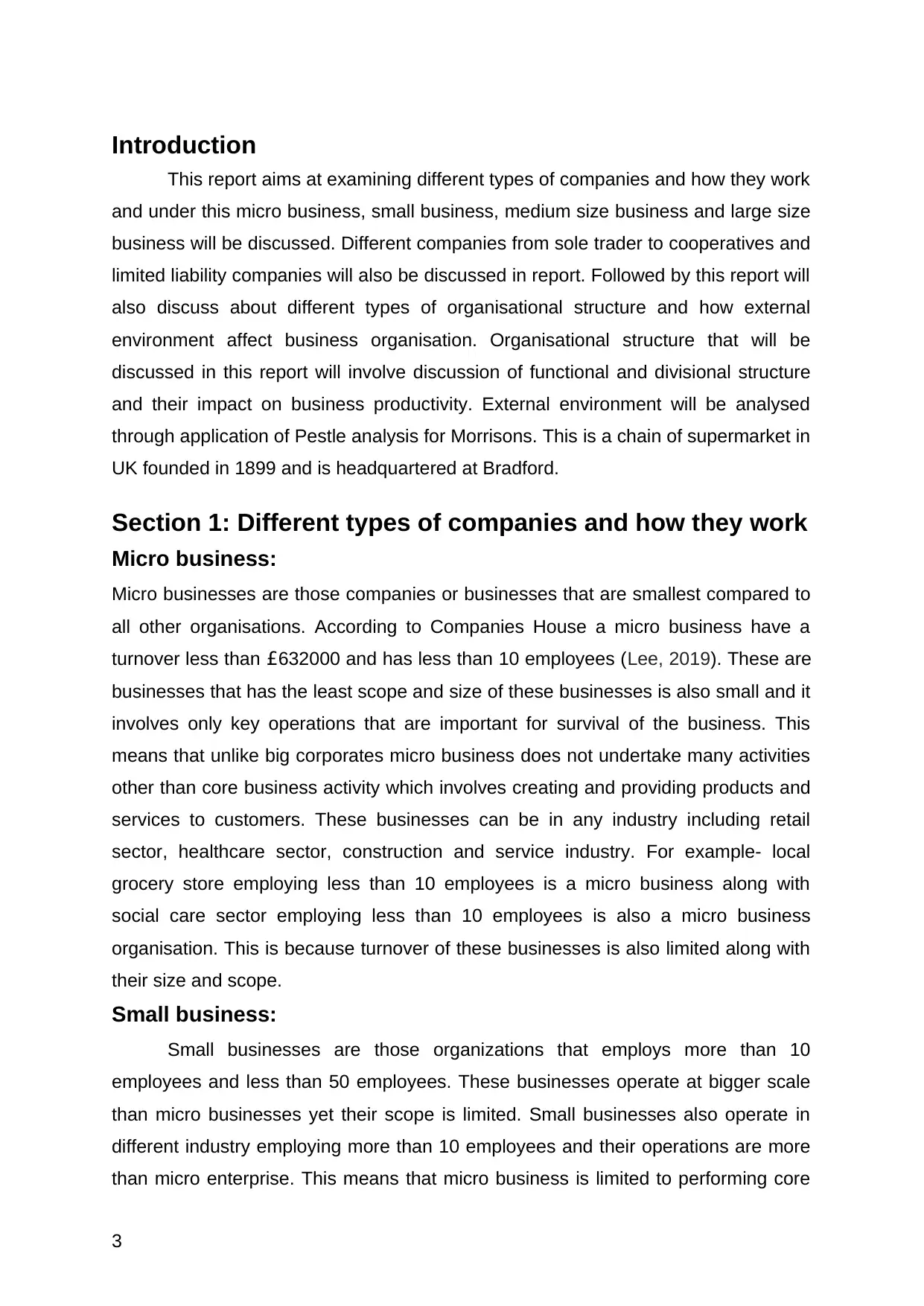
Introduction
This report aims at examining different types of companies and how they work
and under this micro business, small business, medium size business and large size
business will be discussed. Different companies from sole trader to cooperatives and
limited liability companies will also be discussed in report. Followed by this report will
also discuss about different types of organisational structure and how external
environment affect business organisation. Organisational structure that will be
discussed in this report will involve discussion of functional and divisional structure
and their impact on business productivity. External environment will be analysed
through application of Pestle analysis for Morrisons. This is a chain of supermarket in
UK founded in 1899 and is headquartered at Bradford.
Section 1: Different types of companies and how they work
Micro business:
Micro businesses are those companies or businesses that are smallest compared to
all other organisations. According to Companies House a micro business have a
turnover less than £632000 and has less than 10 employees (Lee, 2019). These are
businesses that has the least scope and size of these businesses is also small and it
involves only key operations that are important for survival of the business. This
means that unlike big corporates micro business does not undertake many activities
other than core business activity which involves creating and providing products and
services to customers. These businesses can be in any industry including retail
sector, healthcare sector, construction and service industry. For example- local
grocery store employing less than 10 employees is a micro business along with
social care sector employing less than 10 employees is also a micro business
organisation. This is because turnover of these businesses is also limited along with
their size and scope.
Small business:
Small businesses are those organizations that employs more than 10
employees and less than 50 employees. These businesses operate at bigger scale
than micro businesses yet their scope is limited. Small businesses also operate in
different industry employing more than 10 employees and their operations are more
than micro enterprise. This means that micro business is limited to performing core
3
This report aims at examining different types of companies and how they work
and under this micro business, small business, medium size business and large size
business will be discussed. Different companies from sole trader to cooperatives and
limited liability companies will also be discussed in report. Followed by this report will
also discuss about different types of organisational structure and how external
environment affect business organisation. Organisational structure that will be
discussed in this report will involve discussion of functional and divisional structure
and their impact on business productivity. External environment will be analysed
through application of Pestle analysis for Morrisons. This is a chain of supermarket in
UK founded in 1899 and is headquartered at Bradford.
Section 1: Different types of companies and how they work
Micro business:
Micro businesses are those companies or businesses that are smallest compared to
all other organisations. According to Companies House a micro business have a
turnover less than £632000 and has less than 10 employees (Lee, 2019). These are
businesses that has the least scope and size of these businesses is also small and it
involves only key operations that are important for survival of the business. This
means that unlike big corporates micro business does not undertake many activities
other than core business activity which involves creating and providing products and
services to customers. These businesses can be in any industry including retail
sector, healthcare sector, construction and service industry. For example- local
grocery store employing less than 10 employees is a micro business along with
social care sector employing less than 10 employees is also a micro business
organisation. This is because turnover of these businesses is also limited along with
their size and scope.
Small business:
Small businesses are those organizations that employs more than 10
employees and less than 50 employees. These businesses operate at bigger scale
than micro businesses yet their scope is limited. Small businesses also operate in
different industry employing more than 10 employees and their operations are more
than micro enterprise. This means that micro business is limited to performing core
3
⊘ This is a preview!⊘
Do you want full access?
Subscribe today to unlock all pages.

Trusted by 1+ million students worldwide
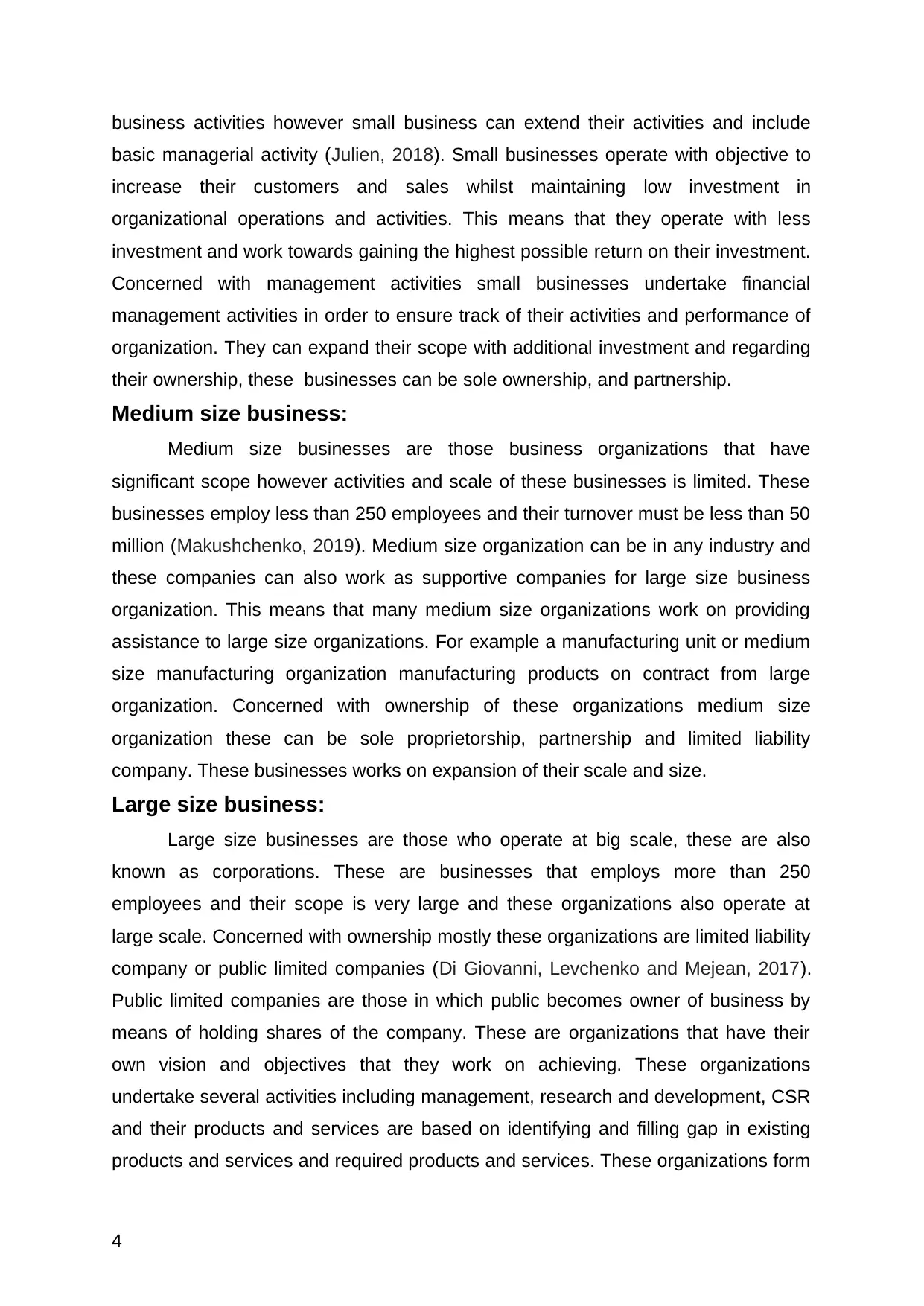
business activities however small business can extend their activities and include
basic managerial activity (Julien, 2018). Small businesses operate with objective to
increase their customers and sales whilst maintaining low investment in
organizational operations and activities. This means that they operate with less
investment and work towards gaining the highest possible return on their investment.
Concerned with management activities small businesses undertake financial
management activities in order to ensure track of their activities and performance of
organization. They can expand their scope with additional investment and regarding
their ownership, these businesses can be sole ownership, and partnership.
Medium size business:
Medium size businesses are those business organizations that have
significant scope however activities and scale of these businesses is limited. These
businesses employ less than 250 employees and their turnover must be less than 50
million (Makushchenko, 2019). Medium size organization can be in any industry and
these companies can also work as supportive companies for large size business
organization. This means that many medium size organizations work on providing
assistance to large size organizations. For example a manufacturing unit or medium
size manufacturing organization manufacturing products on contract from large
organization. Concerned with ownership of these organizations medium size
organization these can be sole proprietorship, partnership and limited liability
company. These businesses works on expansion of their scale and size.
Large size business:
Large size businesses are those who operate at big scale, these are also
known as corporations. These are businesses that employs more than 250
employees and their scope is very large and these organizations also operate at
large scale. Concerned with ownership mostly these organizations are limited liability
company or public limited companies (Di Giovanni, Levchenko and Mejean, 2017).
Public limited companies are those in which public becomes owner of business by
means of holding shares of the company. These are organizations that have their
own vision and objectives that they work on achieving. These organizations
undertake several activities including management, research and development, CSR
and their products and services are based on identifying and filling gap in existing
products and services and required products and services. These organizations form
4
basic managerial activity (Julien, 2018). Small businesses operate with objective to
increase their customers and sales whilst maintaining low investment in
organizational operations and activities. This means that they operate with less
investment and work towards gaining the highest possible return on their investment.
Concerned with management activities small businesses undertake financial
management activities in order to ensure track of their activities and performance of
organization. They can expand their scope with additional investment and regarding
their ownership, these businesses can be sole ownership, and partnership.
Medium size business:
Medium size businesses are those business organizations that have
significant scope however activities and scale of these businesses is limited. These
businesses employ less than 250 employees and their turnover must be less than 50
million (Makushchenko, 2019). Medium size organization can be in any industry and
these companies can also work as supportive companies for large size business
organization. This means that many medium size organizations work on providing
assistance to large size organizations. For example a manufacturing unit or medium
size manufacturing organization manufacturing products on contract from large
organization. Concerned with ownership of these organizations medium size
organization these can be sole proprietorship, partnership and limited liability
company. These businesses works on expansion of their scale and size.
Large size business:
Large size businesses are those who operate at big scale, these are also
known as corporations. These are businesses that employs more than 250
employees and their scope is very large and these organizations also operate at
large scale. Concerned with ownership mostly these organizations are limited liability
company or public limited companies (Di Giovanni, Levchenko and Mejean, 2017).
Public limited companies are those in which public becomes owner of business by
means of holding shares of the company. These are organizations that have their
own vision and objectives that they work on achieving. These organizations
undertake several activities including management, research and development, CSR
and their products and services are based on identifying and filling gap in existing
products and services and required products and services. These organizations form
4
Paraphrase This Document
Need a fresh take? Get an instant paraphrase of this document with our AI Paraphraser
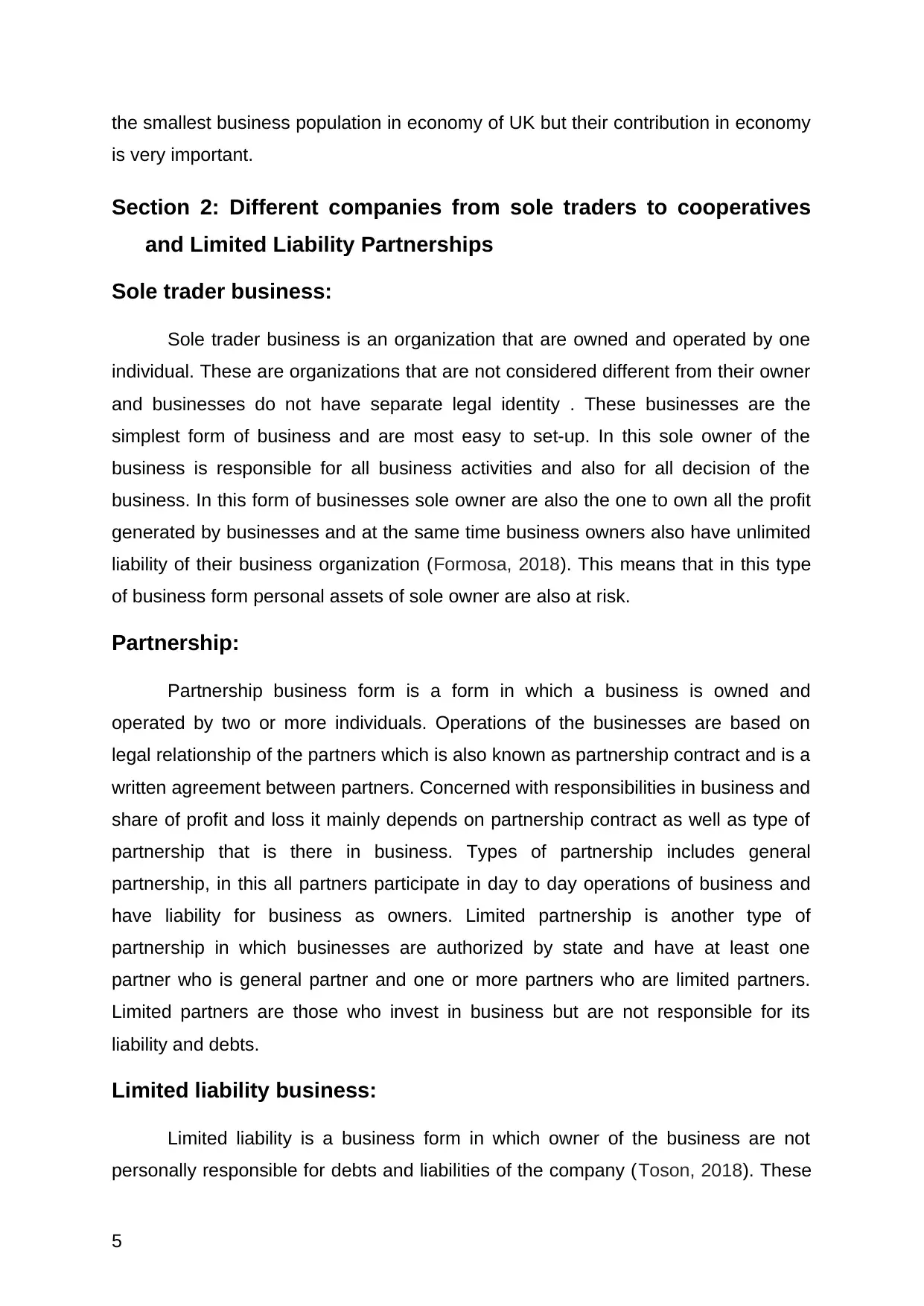
the smallest business population in economy of UK but their contribution in economy
is very important.
Section 2: Different companies from sole traders to cooperatives
and Limited Liability Partnerships
Sole trader business:
Sole trader business is an organization that are owned and operated by one
individual. These are organizations that are not considered different from their owner
and businesses do not have separate legal identity . These businesses are the
simplest form of business and are most easy to set-up. In this sole owner of the
business is responsible for all business activities and also for all decision of the
business. In this form of businesses sole owner are also the one to own all the profit
generated by businesses and at the same time business owners also have unlimited
liability of their business organization (Formosa, 2018). This means that in this type
of business form personal assets of sole owner are also at risk.
Partnership:
Partnership business form is a form in which a business is owned and
operated by two or more individuals. Operations of the businesses are based on
legal relationship of the partners which is also known as partnership contract and is a
written agreement between partners. Concerned with responsibilities in business and
share of profit and loss it mainly depends on partnership contract as well as type of
partnership that is there in business. Types of partnership includes general
partnership, in this all partners participate in day to day operations of business and
have liability for business as owners. Limited partnership is another type of
partnership in which businesses are authorized by state and have at least one
partner who is general partner and one or more partners who are limited partners.
Limited partners are those who invest in business but are not responsible for its
liability and debts.
Limited liability business:
Limited liability is a business form in which owner of the business are not
personally responsible for debts and liabilities of the company (Toson, 2018). These
5
is very important.
Section 2: Different companies from sole traders to cooperatives
and Limited Liability Partnerships
Sole trader business:
Sole trader business is an organization that are owned and operated by one
individual. These are organizations that are not considered different from their owner
and businesses do not have separate legal identity . These businesses are the
simplest form of business and are most easy to set-up. In this sole owner of the
business is responsible for all business activities and also for all decision of the
business. In this form of businesses sole owner are also the one to own all the profit
generated by businesses and at the same time business owners also have unlimited
liability of their business organization (Formosa, 2018). This means that in this type
of business form personal assets of sole owner are also at risk.
Partnership:
Partnership business form is a form in which a business is owned and
operated by two or more individuals. Operations of the businesses are based on
legal relationship of the partners which is also known as partnership contract and is a
written agreement between partners. Concerned with responsibilities in business and
share of profit and loss it mainly depends on partnership contract as well as type of
partnership that is there in business. Types of partnership includes general
partnership, in this all partners participate in day to day operations of business and
have liability for business as owners. Limited partnership is another type of
partnership in which businesses are authorized by state and have at least one
partner who is general partner and one or more partners who are limited partners.
Limited partners are those who invest in business but are not responsible for its
liability and debts.
Limited liability business:
Limited liability is a business form in which owner of the business are not
personally responsible for debts and liabilities of the company (Toson, 2018). These
5
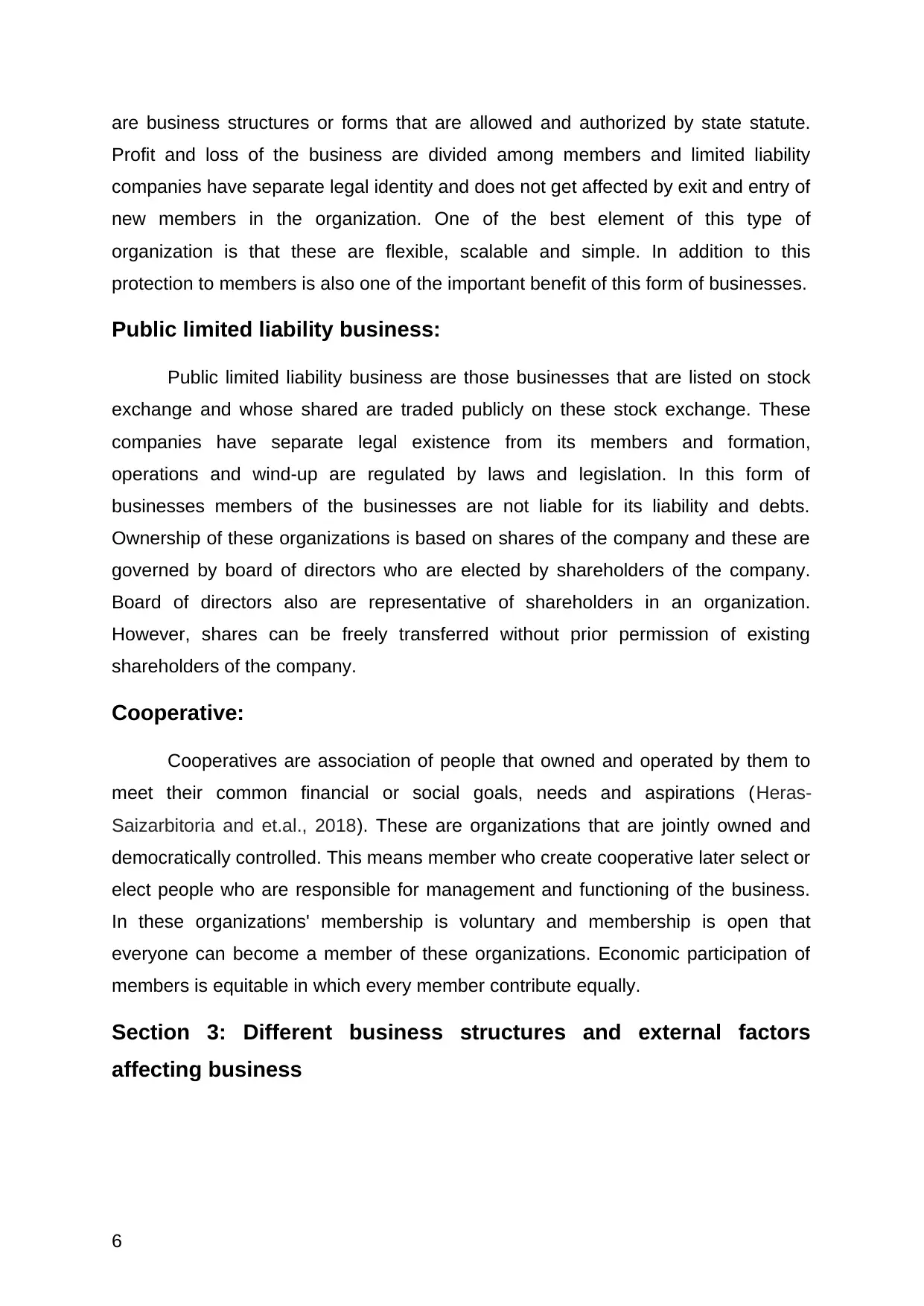
are business structures or forms that are allowed and authorized by state statute.
Profit and loss of the business are divided among members and limited liability
companies have separate legal identity and does not get affected by exit and entry of
new members in the organization. One of the best element of this type of
organization is that these are flexible, scalable and simple. In addition to this
protection to members is also one of the important benefit of this form of businesses.
Public limited liability business:
Public limited liability business are those businesses that are listed on stock
exchange and whose shared are traded publicly on these stock exchange. These
companies have separate legal existence from its members and formation,
operations and wind-up are regulated by laws and legislation. In this form of
businesses members of the businesses are not liable for its liability and debts.
Ownership of these organizations is based on shares of the company and these are
governed by board of directors who are elected by shareholders of the company.
Board of directors also are representative of shareholders in an organization.
However, shares can be freely transferred without prior permission of existing
shareholders of the company.
Cooperative:
Cooperatives are association of people that owned and operated by them to
meet their common financial or social goals, needs and aspirations (Heras-
Saizarbitoria and et.al., 2018). These are organizations that are jointly owned and
democratically controlled. This means member who create cooperative later select or
elect people who are responsible for management and functioning of the business.
In these organizations' membership is voluntary and membership is open that
everyone can become a member of these organizations. Economic participation of
members is equitable in which every member contribute equally.
Section 3: Different business structures and external factors
affecting business
6
Profit and loss of the business are divided among members and limited liability
companies have separate legal identity and does not get affected by exit and entry of
new members in the organization. One of the best element of this type of
organization is that these are flexible, scalable and simple. In addition to this
protection to members is also one of the important benefit of this form of businesses.
Public limited liability business:
Public limited liability business are those businesses that are listed on stock
exchange and whose shared are traded publicly on these stock exchange. These
companies have separate legal existence from its members and formation,
operations and wind-up are regulated by laws and legislation. In this form of
businesses members of the businesses are not liable for its liability and debts.
Ownership of these organizations is based on shares of the company and these are
governed by board of directors who are elected by shareholders of the company.
Board of directors also are representative of shareholders in an organization.
However, shares can be freely transferred without prior permission of existing
shareholders of the company.
Cooperative:
Cooperatives are association of people that owned and operated by them to
meet their common financial or social goals, needs and aspirations (Heras-
Saizarbitoria and et.al., 2018). These are organizations that are jointly owned and
democratically controlled. This means member who create cooperative later select or
elect people who are responsible for management and functioning of the business.
In these organizations' membership is voluntary and membership is open that
everyone can become a member of these organizations. Economic participation of
members is equitable in which every member contribute equally.
Section 3: Different business structures and external factors
affecting business
6
⊘ This is a preview!⊘
Do you want full access?
Subscribe today to unlock all pages.

Trusted by 1+ million students worldwide
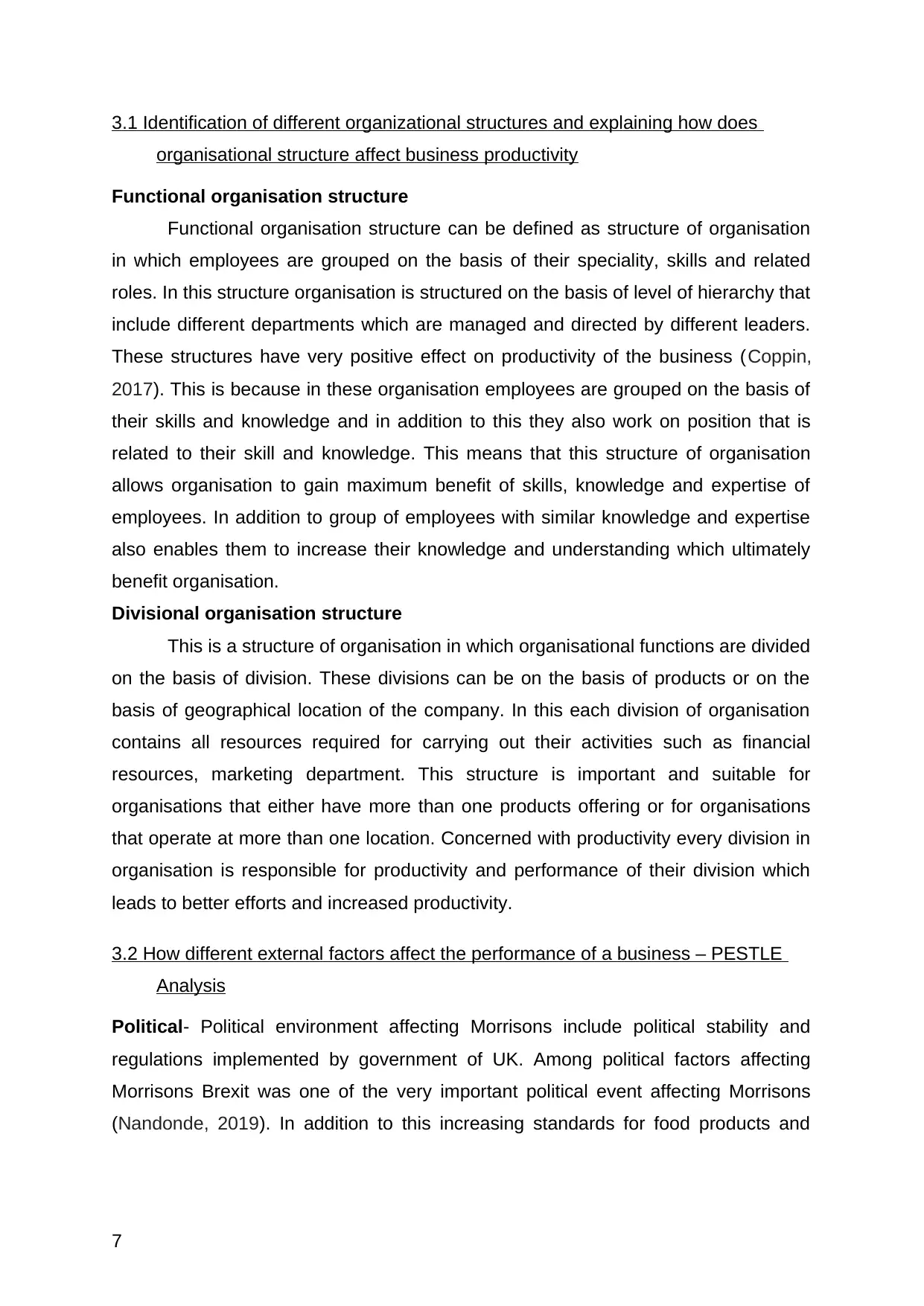
3.1 Identification of different organizational structures and explaining how does
organisational structure affect business productivity
Functional organisation structure
Functional organisation structure can be defined as structure of organisation
in which employees are grouped on the basis of their speciality, skills and related
roles. In this structure organisation is structured on the basis of level of hierarchy that
include different departments which are managed and directed by different leaders.
These structures have very positive effect on productivity of the business (Coppin,
2017). This is because in these organisation employees are grouped on the basis of
their skills and knowledge and in addition to this they also work on position that is
related to their skill and knowledge. This means that this structure of organisation
allows organisation to gain maximum benefit of skills, knowledge and expertise of
employees. In addition to group of employees with similar knowledge and expertise
also enables them to increase their knowledge and understanding which ultimately
benefit organisation.
Divisional organisation structure
This is a structure of organisation in which organisational functions are divided
on the basis of division. These divisions can be on the basis of products or on the
basis of geographical location of the company. In this each division of organisation
contains all resources required for carrying out their activities such as financial
resources, marketing department. This structure is important and suitable for
organisations that either have more than one products offering or for organisations
that operate at more than one location. Concerned with productivity every division in
organisation is responsible for productivity and performance of their division which
leads to better efforts and increased productivity.
3.2 How different external factors affect the performance of a business – PESTLE
Analysis
Political- Political environment affecting Morrisons include political stability and
regulations implemented by government of UK. Among political factors affecting
Morrisons Brexit was one of the very important political event affecting Morrisons
(Nandonde, 2019). In addition to this increasing standards for food products and
7
organisational structure affect business productivity
Functional organisation structure
Functional organisation structure can be defined as structure of organisation
in which employees are grouped on the basis of their speciality, skills and related
roles. In this structure organisation is structured on the basis of level of hierarchy that
include different departments which are managed and directed by different leaders.
These structures have very positive effect on productivity of the business (Coppin,
2017). This is because in these organisation employees are grouped on the basis of
their skills and knowledge and in addition to this they also work on position that is
related to their skill and knowledge. This means that this structure of organisation
allows organisation to gain maximum benefit of skills, knowledge and expertise of
employees. In addition to group of employees with similar knowledge and expertise
also enables them to increase their knowledge and understanding which ultimately
benefit organisation.
Divisional organisation structure
This is a structure of organisation in which organisational functions are divided
on the basis of division. These divisions can be on the basis of products or on the
basis of geographical location of the company. In this each division of organisation
contains all resources required for carrying out their activities such as financial
resources, marketing department. This structure is important and suitable for
organisations that either have more than one products offering or for organisations
that operate at more than one location. Concerned with productivity every division in
organisation is responsible for productivity and performance of their division which
leads to better efforts and increased productivity.
3.2 How different external factors affect the performance of a business – PESTLE
Analysis
Political- Political environment affecting Morrisons include political stability and
regulations implemented by government of UK. Among political factors affecting
Morrisons Brexit was one of the very important political event affecting Morrisons
(Nandonde, 2019). In addition to this increasing standards for food products and
7
Paraphrase This Document
Need a fresh take? Get an instant paraphrase of this document with our AI Paraphraser
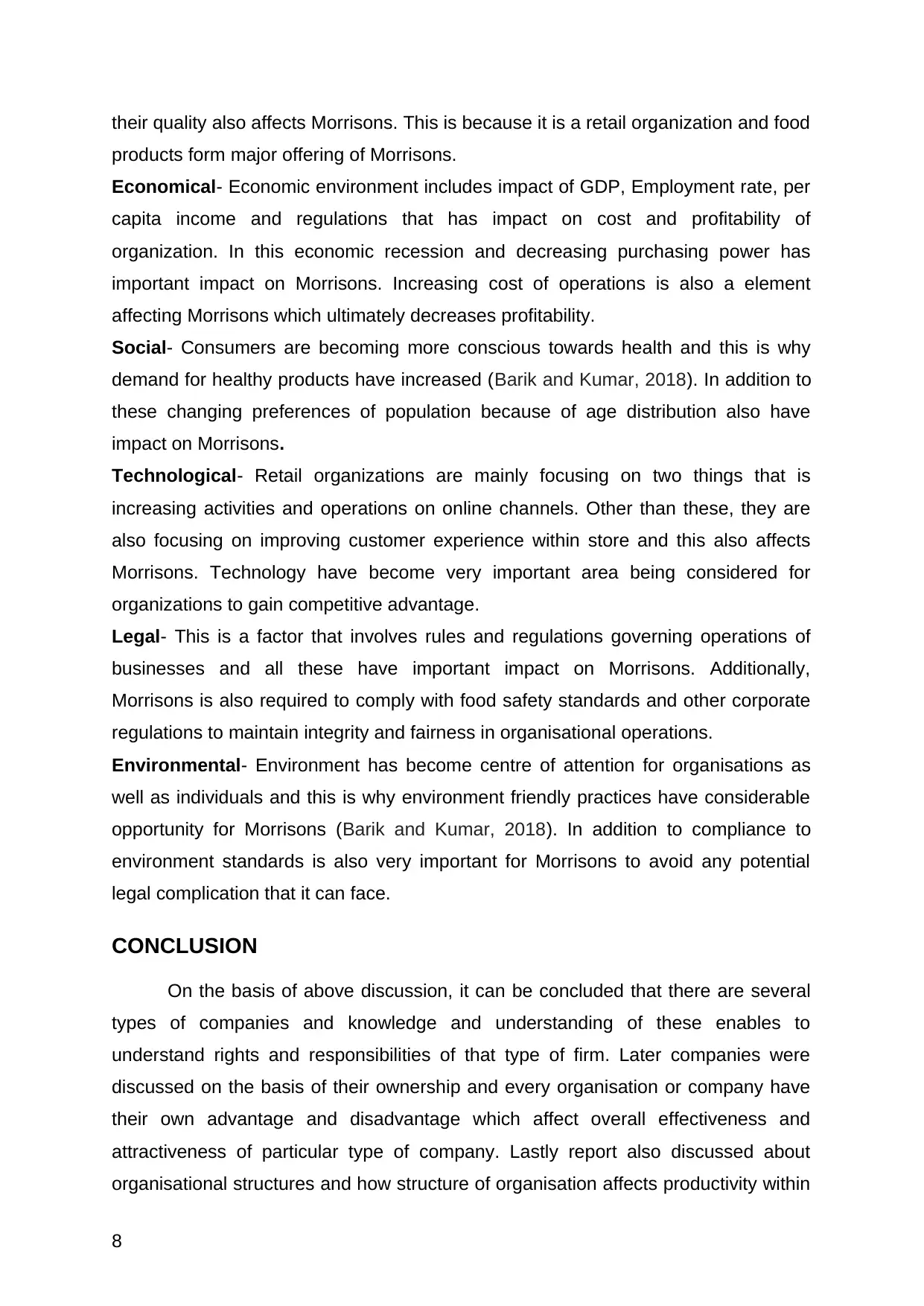
their quality also affects Morrisons. This is because it is a retail organization and food
products form major offering of Morrisons.
Economical- Economic environment includes impact of GDP, Employment rate, per
capita income and regulations that has impact on cost and profitability of
organization. In this economic recession and decreasing purchasing power has
important impact on Morrisons. Increasing cost of operations is also a element
affecting Morrisons which ultimately decreases profitability.
Social- Consumers are becoming more conscious towards health and this is why
demand for healthy products have increased (Barik and Kumar, 2018). In addition to
these changing preferences of population because of age distribution also have
impact on Morrisons.
Technological- Retail organizations are mainly focusing on two things that is
increasing activities and operations on online channels. Other than these, they are
also focusing on improving customer experience within store and this also affects
Morrisons. Technology have become very important area being considered for
organizations to gain competitive advantage.
Legal- This is a factor that involves rules and regulations governing operations of
businesses and all these have important impact on Morrisons. Additionally,
Morrisons is also required to comply with food safety standards and other corporate
regulations to maintain integrity and fairness in organisational operations.
Environmental- Environment has become centre of attention for organisations as
well as individuals and this is why environment friendly practices have considerable
opportunity for Morrisons (Barik and Kumar, 2018). In addition to compliance to
environment standards is also very important for Morrisons to avoid any potential
legal complication that it can face.
CONCLUSION
On the basis of above discussion, it can be concluded that there are several
types of companies and knowledge and understanding of these enables to
understand rights and responsibilities of that type of firm. Later companies were
discussed on the basis of their ownership and every organisation or company have
their own advantage and disadvantage which affect overall effectiveness and
attractiveness of particular type of company. Lastly report also discussed about
organisational structures and how structure of organisation affects productivity within
8
products form major offering of Morrisons.
Economical- Economic environment includes impact of GDP, Employment rate, per
capita income and regulations that has impact on cost and profitability of
organization. In this economic recession and decreasing purchasing power has
important impact on Morrisons. Increasing cost of operations is also a element
affecting Morrisons which ultimately decreases profitability.
Social- Consumers are becoming more conscious towards health and this is why
demand for healthy products have increased (Barik and Kumar, 2018). In addition to
these changing preferences of population because of age distribution also have
impact on Morrisons.
Technological- Retail organizations are mainly focusing on two things that is
increasing activities and operations on online channels. Other than these, they are
also focusing on improving customer experience within store and this also affects
Morrisons. Technology have become very important area being considered for
organizations to gain competitive advantage.
Legal- This is a factor that involves rules and regulations governing operations of
businesses and all these have important impact on Morrisons. Additionally,
Morrisons is also required to comply with food safety standards and other corporate
regulations to maintain integrity and fairness in organisational operations.
Environmental- Environment has become centre of attention for organisations as
well as individuals and this is why environment friendly practices have considerable
opportunity for Morrisons (Barik and Kumar, 2018). In addition to compliance to
environment standards is also very important for Morrisons to avoid any potential
legal complication that it can face.
CONCLUSION
On the basis of above discussion, it can be concluded that there are several
types of companies and knowledge and understanding of these enables to
understand rights and responsibilities of that type of firm. Later companies were
discussed on the basis of their ownership and every organisation or company have
their own advantage and disadvantage which affect overall effectiveness and
attractiveness of particular type of company. Lastly report also discussed about
organisational structures and how structure of organisation affects productivity within
8
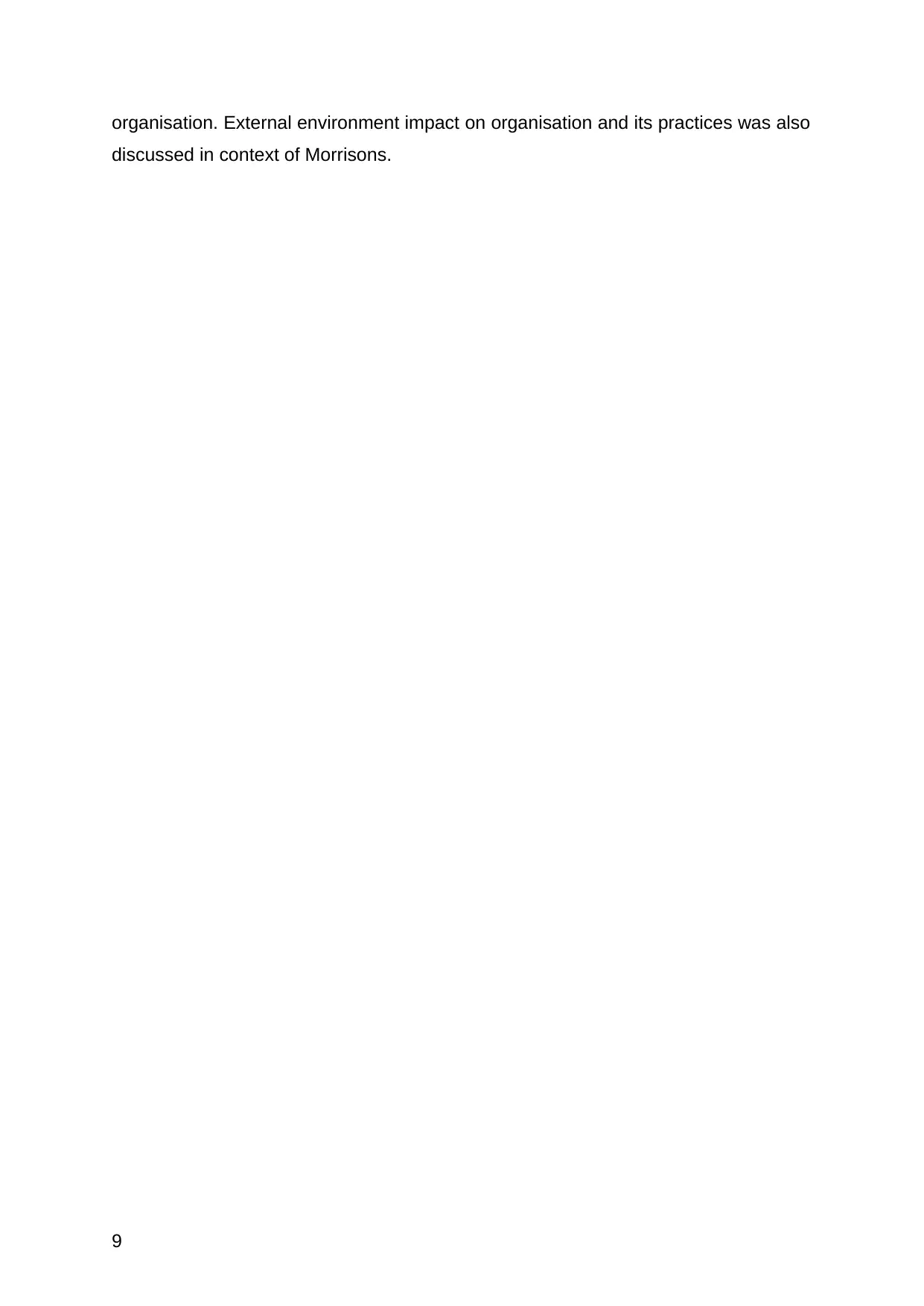
organisation. External environment impact on organisation and its practices was also
discussed in context of Morrisons.
9
discussed in context of Morrisons.
9
⊘ This is a preview!⊘
Do you want full access?
Subscribe today to unlock all pages.

Trusted by 1+ million students worldwide
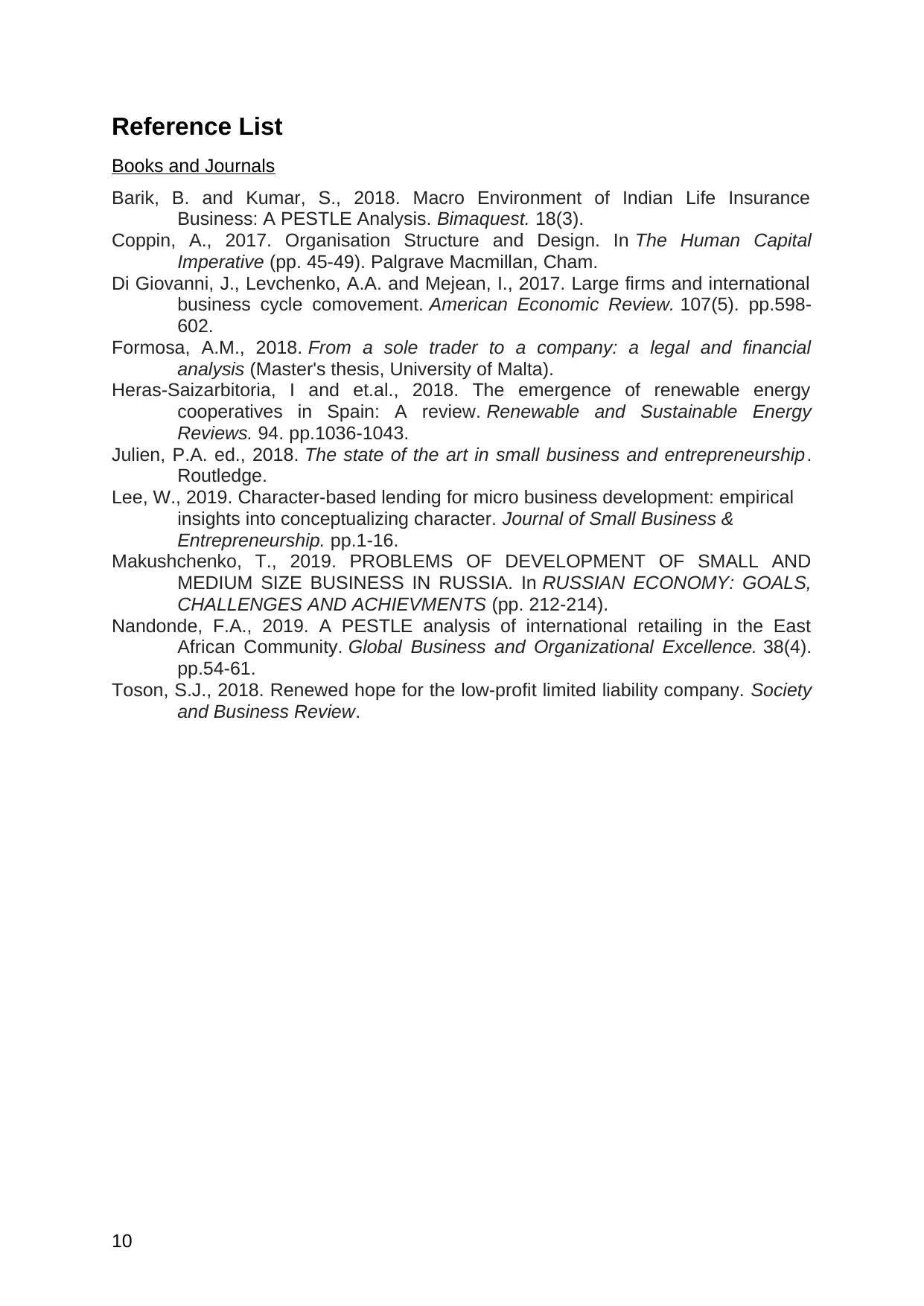
Reference List
Books and Journals
Barik, B. and Kumar, S., 2018. Macro Environment of Indian Life Insurance
Business: A PESTLE Analysis. Bimaquest. 18(3).
Coppin, A., 2017. Organisation Structure and Design. In The Human Capital
Imperative (pp. 45-49). Palgrave Macmillan, Cham.
Di Giovanni, J., Levchenko, A.A. and Mejean, I., 2017. Large firms and international
business cycle comovement. American Economic Review. 107(5). pp.598-
602.
Formosa, A.M., 2018. From a sole trader to a company: a legal and financial
analysis (Master's thesis, University of Malta).
Heras-Saizarbitoria, I and et.al., 2018. The emergence of renewable energy
cooperatives in Spain: A review. Renewable and Sustainable Energy
Reviews. 94. pp.1036-1043.
Julien, P.A. ed., 2018. The state of the art in small business and entrepreneurship.
Routledge.
Lee, W., 2019. Character-based lending for micro business development: empirical
insights into conceptualizing character. Journal of Small Business &
Entrepreneurship. pp.1-16.
Makushchenko, T., 2019. PROBLEMS OF DEVELOPMENT OF SMALL AND
MEDIUM SIZE BUSINESS IN RUSSIA. In RUSSIAN ECONOMY: GOALS,
CHALLENGES AND ACHIEVMENTS (pp. 212-214).
Nandonde, F.A., 2019. A PESTLE analysis of international retailing in the East
African Community. Global Business and Organizational Excellence. 38(4).
pp.54-61.
Toson, S.J., 2018. Renewed hope for the low-profit limited liability company. Society
and Business Review.
10
Books and Journals
Barik, B. and Kumar, S., 2018. Macro Environment of Indian Life Insurance
Business: A PESTLE Analysis. Bimaquest. 18(3).
Coppin, A., 2017. Organisation Structure and Design. In The Human Capital
Imperative (pp. 45-49). Palgrave Macmillan, Cham.
Di Giovanni, J., Levchenko, A.A. and Mejean, I., 2017. Large firms and international
business cycle comovement. American Economic Review. 107(5). pp.598-
602.
Formosa, A.M., 2018. From a sole trader to a company: a legal and financial
analysis (Master's thesis, University of Malta).
Heras-Saizarbitoria, I and et.al., 2018. The emergence of renewable energy
cooperatives in Spain: A review. Renewable and Sustainable Energy
Reviews. 94. pp.1036-1043.
Julien, P.A. ed., 2018. The state of the art in small business and entrepreneurship.
Routledge.
Lee, W., 2019. Character-based lending for micro business development: empirical
insights into conceptualizing character. Journal of Small Business &
Entrepreneurship. pp.1-16.
Makushchenko, T., 2019. PROBLEMS OF DEVELOPMENT OF SMALL AND
MEDIUM SIZE BUSINESS IN RUSSIA. In RUSSIAN ECONOMY: GOALS,
CHALLENGES AND ACHIEVMENTS (pp. 212-214).
Nandonde, F.A., 2019. A PESTLE analysis of international retailing in the East
African Community. Global Business and Organizational Excellence. 38(4).
pp.54-61.
Toson, S.J., 2018. Renewed hope for the low-profit limited liability company. Society
and Business Review.
10
1 out of 10
Related Documents
Your All-in-One AI-Powered Toolkit for Academic Success.
+13062052269
info@desklib.com
Available 24*7 on WhatsApp / Email
![[object Object]](/_next/static/media/star-bottom.7253800d.svg)
Unlock your academic potential
Copyright © 2020–2025 A2Z Services. All Rights Reserved. Developed and managed by ZUCOL.





